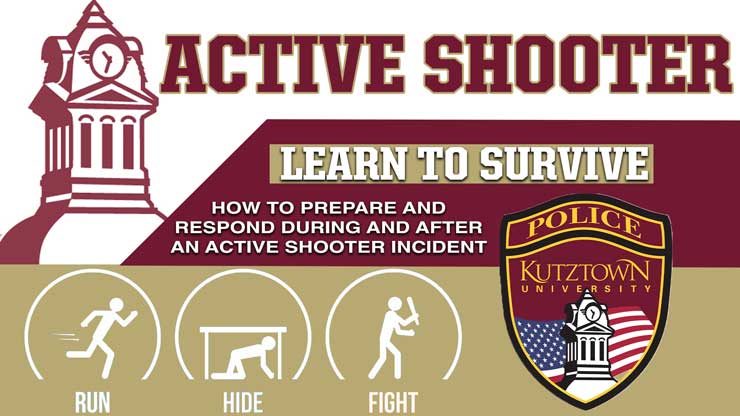Run. Hide. Fight.
Active Shooter Response

An active shooter is an individual actively engaged in killing or attempting to kill people in a confined and populated area, typically through the use of firearms.
- Victims are most often selected at random.
- The event is unpredictable and evolves quickly.
- When an active shooter is in your vicinity, you must be prepared both mentally and physically to deal with the situation.
You have three options:
Run
- Have an escape route and plan in mind.
- Leave your belongings behind.
- Evacuate regardless of whether others agree to follow.
- Help others escape, if possible.
- Do not attempt to move wounded people.
- Prevent others from entering an area where the active shooter may be.
- Keep your hands visible.
- Call 9-1-1 when you are safe.
Hide
- Hide in an area out of the shooter’s view.
- Lock the door or block the entry to your hiding place.
- Silence your cell phone (including the vibration) and remain quiet.
Fight
- Fight as a last resort and only when your life is in immediate danger.
- Attempt to incapacitate the shooter.
- Act with as much physical aggression as possible.
- Improvise weapons or throw items at the active shooter.
- Commit to your actions…your life depends on it.
When Law Enforcement Arrives:
- Remain calm and follow instructions.
- Put down any items in your hands (i.e., bags, jackets).
- Raise hands and spread fingers.
- Keep hands visible at all times.
- Avoid quick movements toward officers such as holding on to them for safety.
- Avoid pointing, screaming, or yelling.
- Do not stop to ask officers for help or direction when evacuating.
Information to Provide to the 9-1-1 Operator
If you are able, try and remember the following information so you can provide it to the dispatcher when you call 9-1-1:
- Location of the active shooter(s).
- Number of shooter(s).
- Physical description of shooter(s).
- Number and type of weapons held by shooter(s).
- Number of potential victims at the location.
The first officers to arrive to the scene will not stop to help injured people. Expect rescue teams to follow the initial officers. These rescue teams will treat and remove the injured.
Once you have reached a safe location, you will likely be held in that area by law enforcement until the situation is under control, and all witnesses have been identified and questioned.
Additional Resources:
- Kutztown University Safety & Emergency Information
- FBI's Run. Hide. Fight Video (see below)






